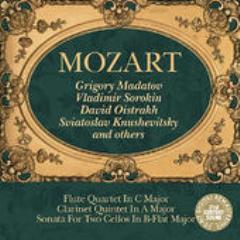Mozart – Clarinet Quintet-Flute Quartet-Sonata for Bassoon and Cello (2007)
Mozart – Clarinet Quintet-Flute Quartet-Sonata for Bassoon and Cello (2007)

Clarinet Quintet In a Major, K. 581 1. I. Allegro 8:47 2. II. Larghetto 7:17 3. III. Menuetto 7:01 4. IV. Allegretto Con Variazioni 9:03 Flute Quartet No. 3 In C Major, K. Anh. 171 (K. 285b): 5. I. Allegro 8:49 6. II. Andantino 11:37 7. Sonata In B-Flat Major K. 292: I. Allegro, II. Andante, II. Rondo Allegro 13:24 David Oistrakh – violin (1-6) Michael Terian – viola (1-6) Pyotr Bondarenko – violin (1-4) Sviatoslav Knushevitsky - cello (1-7) Vladimir Sorokin – clarinet (1-4) Grigory Madatov – flute (5-6) Alexandr Vlasov (7)
The years 1789 and 1790 were the most difficult of Mozart's career; during this period his financial difficulties escalated, and his popularity as a performer waned with the fickle Viennese public. Not surprisingly given such circumstances, these years witnessed a dramatic decline in the number of works Mozart produced. However at some point late in the summer of 1789 Mozart received a commission for a new opera from the Emperor Joseph II. By the time he began composing the opera in question, Così fan tutte, he must also have been at work on what would become one of his most popular chamber works, the Clarinet Quintet in A. Not only does the quintet predominantly bask in that same golden warmth and mellowness that characterizes much of Così, but a sketch for its finale became "Ah lo veggio," one of Ferrando's arias from Act Two of the opera. The Quintet was completed by the end of September 1789 -- perhaps the 29th, as indicated in Mozart's thematic catalog.
It was composed for the outstanding clarinetist Anton Stadler (1753-1812), a member of the court orchestra in Vienna and a friend of Mozart's from the time the latter first settled in Vienna in 1781. Mozart had already composed a number of chamber works for Stadler and his brother Mathias, some of which were actually for basset horn. In addition this playing the lower pitched instrument, Anton Stadler was noted for his ability to exploit the low register of the standard clarinet; to enable his exploration of this so-called chalumeau range he devised an additional extension for the instrument. It was for this modified instrument that Mozart composed both the Clarinet Quintet and the famous Clarinet Concerto in A, K. 622 -- one of his last works. Although playing the work on a modern clarinet requires less transposition of low notes than is the case with the Concerto, the work is still best heard on an instrument that allows the original pitch to be heard; several recordings have been made on clarinets that reconstruct Stadler's instrument.
The quintet is scored for clarinet, two violins, viola, and cello, and is cast in four movements. The opening Allegro, a discourse between all five instruments, is tinged with sadness; the exquisitely lovely Larghetto that follows brings the clarinet more into the limelight, its rapturous lines supported throughout by muted strings. The Minuetto is particularly notable for the first of its two trios. The final movement is a set of variations based on one of those innocent, almost childish-sounding themes Mozart so often employed in his finales. But, as is also typical of Mozart, the manner in which the composer develops a wide variety of moods and musical textures rings enormous richness from the material, and allows the clarinetist to display great virtuosity. ---Brian Robins, Rovi
The Köchel catalog number of K. 285 number for the C major Flute Quartet is misleading. Despite being adjacent to those of the two quartets Mozart completed while he was in Mannheim as a result of a commission from the Dutchman Ferdinand Dejean in 1777 and 1778, it is now known to have been composed in Vienna rather later. While no reliable autograph manuscript exists, a sketch of ten bars of the opening Allegro has been discovered, and the same leaf also includes one of the arias from the German opera Die Entführung aus dem Serail, on which Mozart was working during the latter part of 1781 and 1782. The quartet can therefore be dated to this period, a conclusion confirmed by paper analysis. In addition, the second of the two movements, the Theme and Variations (marked Andantino) has a close relationship with another work dating from this period, being a simplified version of the sixth movement of the magnificent Serenade for 13 Wind Instruments, K. 361. The authenticity of this arrangement has been questioned, as has Mozart's authorship of the final bars of the Allegro. Quite why Mozart should have returned to composing a quartet featuring an instrument he disliked without apparent motive is a puzzle, the most likely explanation being that, like its successor (the Flute Quartet in A, K. 298), it was composed or arranged for the domestic enjoyment of friends. The scoring is the same as that of the other flute quartets; flute, violin, viola, and cello. ---Brian Robins, Rovi
download (mp3 @92 kbs):
uploaded yandex 4shared mega mediafire solidfiles zalivalka cloudmailru oboom








